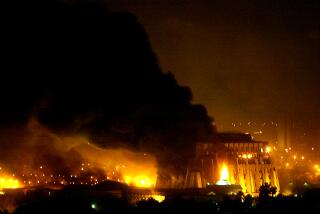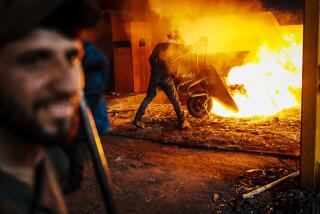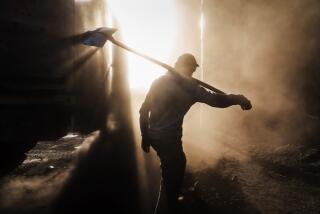‘Fighting Season’ Returns to Afghans’ Forgotten War : Asia: The U.S. and Soviets, while still supplying the respective sides, wish the hostilities would end.
- Share via
KABUL, Afghanistan — Beside black banners bearing Koranic prayers, memorial photographs and a shrine of red tulips, the students and teachers of Kabul University gathered outside the School of Agriculture to mourn their dead--the latest casualties in one of the world’s bloodiest wars, a conflict that has claimed more than 1 million lives in a dozen years.
The latest campus casualties occurred Saturday, when a U.S.-bought rocket slammed into the sidewalk beside the American-built agricultural school. The students were on break at the time, lounging in the spring sunshine and chatting in groups, when suddenly the rocket whistled in, sending shrapnel ripping through four students and a young teacher who died on the spot.
Dozens of rebel rockets rained on Kabul that day. They were a bloody, painful reminder that the relative peace of the Afghan winter again is giving way to another season of war, the spring that Afghans now know only as the “fighting season.”
But the rebels’ weekend rocket barrage at Kabul--deliberately timed for Saturday’s 13th anniversary of the Marxist revolution that ushered in Afghanistan’s decade of darkness--went all but unnoticed in a world now preoccupied with other crises and wars.
And the scene that unfolded this week at Kabul University, a campus built and paid for by the United States 26 years ago, was a reminder of how Afghanistan has become the world’s forgotten war. It is a conflict that the Americans and Soviets continue to fight by proxy but wish would go away.
“Afghanistan doesn’t bother the world anymore,” Dr. Khairulah Dawalty, an aging Kabul University agriculture professor, declared Tuesday as he sat with a group of teachers, students and two U.S. journalists.
“It’s just part of the culture of the world now, this war,” said the professor, who holds graduate degrees from the universities of Wyoming and Tennessee. “Who is going to take care of the Afghan people from now on? This is a dark spot in the world, and there is no flashlight to see what’s going on inside.”
It has been more than two years since the Soviets pulled their 115,000 occupation troops out of Afghanistan, an invasion force that so enraged the United States a decade ago that Washington ordered a boycott of the 1980 Moscow Olympics and launched a massive, covert arms supply to the moujahedeen rebels.
But since the troop pullout, Moscow and Washington have continued to rearm their allies. Despite several rounds of talks to achieve “negative symmetry,” a simultaneous cessation of arms supplies to both sides, neither the Soviets nor the Americans have managed to reach such an agreement.
Soviet leaders, facing increasing ethnic strife in their heavily Islamic southern republics, have been reluctant to withdraw support from the secular, pro-Moscow government of President Najibullah.
And Washington has been equally reluctant to stop backing a force responsible for the Red Army’s humbling defeat here. (Washington’s support for the moujahedeen has softened measurably amid the Afghan rebel leaders’ increasingly anti-American fundamentalist stands, including their opposition to the U.S. role in the Persian Gulf.)
Most analysts here and in neighboring Pakistan--a key U.S. ally that has harbored the rebels’ military bases, provided haven to more than 3 million Afghan refugees and acted as a conduit for U.S. arms to the moujahedeen-- have said that this year may well be the last for U.S. involvement in the Afghan conflict.
In the next few weeks, the U.S. Senate and House Intelligence committees will meet secretly to decide whether to release $125 million more in covert arms aid to continue funding the moujahedeen. Although the committees are likely to release the money, most analysts believe that this will be the last of it.
“But each year, we hear, ‘This is going to be the last fighting season,’ ” said one diplomat in Kabul. “And yet every spring, the killing continues. Each year the (Kabul) regime gains a little, the moujahedeen gain a little. And thousands more Afghans die. No wonder the Afghans think the world has forgotten them.”
Indeed, the battlefield this spring already is typical of this largely psychological seesaw war. Last month, the moujahedeen scored their biggest success since forcing the Soviets to withdraw, capturing Khost, a city near the Pakistan border, after an 18-day fight that saw the defection of thousands of government troops and the capture of thousands more.
Last week, the regime retaliated. In just three days, it pounded the rebels out of key positions they held in the Logar Valley, just 40 miles south of Kabul. The regime recaptured dozens of square miles of strategic real estate controlled by the moujahedeen for years.
Clearly, the regime staged the battle in Logar not only to expand its security ring around the beleaguered capital, which the rebels again say is their ultimate target during this fighting season, but also to recover major propaganda points lost in the fall of Khost.
Farid Ahmad Mazdak, deputy chairman of Najibullah’s ruling party and a key young strategist for the regime, conceded that the loss of Khost was a major psychological defeat.
“All through the years of war, Khost was depicted as a very staunch stronghold of the government,” he told a handful of Western journalists this week. Mazdak stressed that the regime has been “pulling itself back together” since the defeat, citing the Logar Valley battle as proof it remains strong.
To underscore the point, the regime packed 36 Kabul-based diplomats into a bus just hours after the Logar battle ended last Friday to show off the huge rebel arms caches it seized and its ability to traverse a key supply road from Kabul to other cities now under rebel rocket attack.
The regime this week has taken several Western journalists on the same tour, which included a long briefing by Gen. Mohammed Nabi Azimi, the deputy defense minister, a top adviser to Najibullah and commander of the Kabul garrison.
Unlike Mazdak, who cited government defections as partially responsible for the loss of Khost, Azimi blamed it on Pakistani military involvement. He said the battle to recover Logar was a deliberate message to show “our morale is still very good.”
“This is their (the rebels’) first lesson,” the burly general said in a near whisper. “We have other lessons planned for them. But I hope they have learned it in this battlefield and will now be ready to sit and talk.”
But most experts on the Afghan conflict believe that such negotiations are unlikely in the near future, the general said, adding, “If you want to know the plan of the opposition, yes, it is another hot summer--to continue these attacks and firing their rockets.”
But it was the destruction of 12 years of war, and not just a three-day firefight, that was most striking in the recently retaken Logar Valley. There, for mile after mile, were remains of mud villages, flattened and abandoned during Soviet bombing runs of years past. Like prehistoric ruins, the broken houses and village walls appeared as long-forgotten tombstones all along the main road, which itself was deeply pitted and barely passable from years of rebel rocket and land-mine attacks.
Most of the refugees from those villages now live in Kabul, and, for the more than 1 million residents of the Afghan capital, a city where the population was just a few hundred thousand before the war, the prospect of yet another fighting season is as damaging as the rocket that hit the university last weekend.
Bread and cooking oil are in stock in most Kabul shops, unlike in previous years. But no one can afford them. Annual inflation of 100% or more has put most goods out of reach of the already impoverished population. The distribution of government rations of bread to the poor trigger daily food riots; only the wealthiest can afford a few slices of meat each week.
And everywhere, there are legless men hobbling on crutches, part of the giant war-amputee population.
Some of the starkest images were at Kabul University, where an agriculture student named Hamid took two American journalists on an impromptu tour of the spot where the rocket hit last Saturday.
Hamid is 20 years old. More than half of his life has been consumed with war and a fear so deep that not once since he was born has he left Kabul, even to visit the suburbs.
“Before the revolution, I remember some things,” he said in halting English. “I was about 8 years old. We didn’t need this revolution. It was a good condition for us before revolution. But since the revolution started, we have no life any more.”
In an effort to win back his people’s support, Najibullah has continued a policy of perestroika- like reform, abandoning the communist ideology behind the revolution that brought to power his ruling People’s Democratic Party of Afghanistan. He has changed the name of the party to Watan, or homeland, and renamed the Politburo the Executive Board--”just like an American corporation,” said one regime spokesman with a smile.
But most analysts say Najibullah’s hold on power remains supreme. And for young men like Hamid, the realities of life remain bitter.
“Everything in life is a toil for us,” he said. “I only feel this war. Nothing else. And when I finish school, there is nothing.”
Just then, Hamid was interrupted. A former student, visiting his old campus that day, chanced upon the rocket shell, still embedded in the sidewalk. He paused and stared down at it, leaning heavily on his metal crutches.
“He was walking to the bazaar, and a rocket came and cut his leg,” Hamid explained, as the young amputee stared at the hole, as if he were looking at his past, his present and his future all at once. “It happened to him three years ago.
“This man is Faiz Mohammed,” Hamid added. “He was a student in the Pharmacy School. He couldn’t finish his studies because his leg was cut. Now he is jobless. He wanted to be a good pharmacist, but because of this war, he couldn’t continue. Now, for him, there is nothing.”
BACKGROUND
Mohammed Zahir Shah, Afghanistan’s last king, ruled from 1933 to 1973, before his overthrow in a coup engineered by his cousin, Lt. Gen. Mohammed Daoud. Daoud declared the nation a republic and, after a National Assembly met and a constitution was drafted, was elected president. In March, 1977, he formed a civilian government. But dissatisfaction with Daoud led to his ouster and death in an April, 1978, left-wing coup that installed Nur Mohammed Taraki. He sought to create a Marxist state with Soviet aid but met armed resistance from conservative Muslims. Taraki was replaced in September, 1979, by party hard-liner Hafizullah Amin. A Soviet invasion in late December, 1979, supported a coup that led to Amin’s death and his replacement by party rival Babrak Karmal. Soviet forces increased to more than 100,000 and supported Afghan troops in costly fighting against Afghan moujahedeen (“holy warriors”) based in Pakistan. Karmal stepped down in 1986 and Najibullah took over.
More to Read
Sign up for Essential California
The most important California stories and recommendations in your inbox every morning.
You may occasionally receive promotional content from the Los Angeles Times.













